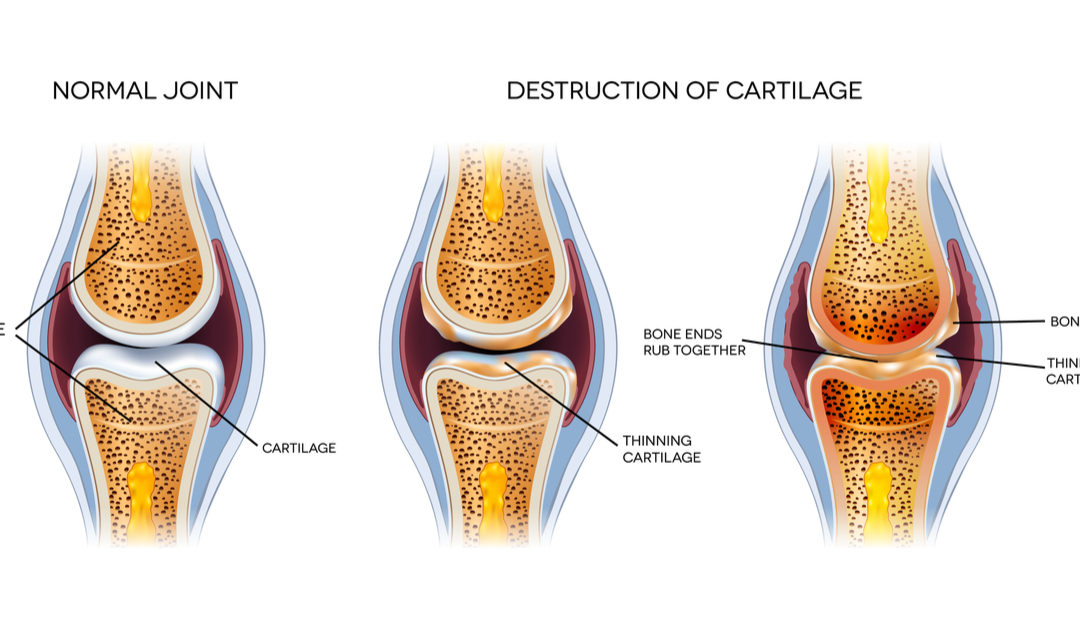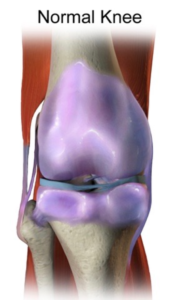The knee joint is composed of the femur, tibia and patella bones and its primary action is to flex and extend the lower leg while walking and running. Because this important action controls daily life, protecting the integrity of the joint is of the utmost importance. One of the key protective elements of the knee is cartilage. It should be taken special care of throughout one’s lifetime.
Knee Cartilage Defined
There are 2 types of cartilage in the knee joints. Fibrocartilage is the rubbery, elastic form of cartilage that forms the menisci, or “shock absorbers” of the knee joint. Hyaline Cartilage is a special type of elastic, compressible, tissue that coats the ends of all bones that form joints in the body. In the knee, hyaline cartilage is the smooth, shiny substance that can be found on the condyles of the femur, back of the patella, and on top of the tibia. When healthy, knee cartilage allows the joint to move smoothly and serves as a shock absorber—bracing the load placed on the joint when the foot impacts the ground.
Illustration 1- The cartilage of a normal knee is highlighted in purple
Because the knee experiences a great deal of use over the course of a lifetime, cartilage is susceptible to damage.
How Knee Cartilage is Damaged
Cartilage can be damaged in two ways:
The first relates to participation in athletics or physical activity. When twisting, turning, and torqueing the knee, cartilage can be partially or completely torn resulting in such injuries as a meniscal tear. Direct trauma to the knee can result in an injury to the hyaline cartilage and dislodge a piece of this cartilage from the bone, resulting in an area of exposed bone. This type of injury can cause bone on bone rubbing, which can cause pain and limit the performance of an injured athlete.
The second relates to the development of osteoarthritis, a disease that causes a wearing away of the cartilage on the ends of the bone, eventually resulting in bone rubbing on bone, and thus cause pain. This disease usually progresses as we age, and once it occurs a host of unpleasant symptoms, namely pain and swelling of the joints occurs, decreasing the quality of life and ability to function.
Illustration 2- Cartilage that has been affected by osteoarthritis
Protecting Knee Cartilage
There are numerous ways to protect knee cartilage from injury and arthritis. Four great ones are:
- Stretching and strengthening all the muscles of the leg
- Using proper form when participating in athletics
- Avoiding overtraining
- Seeing an orthopedic specialist when symptoms such a knee pain or swelling occur.
Preventing knee cartilage damage is an important part of maintaining one’s overall health. When taken care of, there’s no reason why cartilage can’t last a lifetime.
What to Do If You’re in Pain or Injured
Orthopedic specialists are the most qualified medical professionals to take care of cartilage injuries. Their education, skills, and experience allow them to accurately diagnose and effectively treat injuries, so patients can return to a normal life. If you’re in pain or have sustained an injury, please don’t hesitate to contact our office to arrange an appointment—we will get you in ASAP.
Dr. Nicholas Alexander is the Founder of Mahwah Valley Orthopedics and a Board Certified Orthopedic Surgeon specializing in both the surgical and non-surgical treatment of hip and knee conditions. Dr. Alexander completed his Fellowship in Adult Reconstruction and Reconstructive Surgery of the Hip and Knee at the Johns Hopkins School of Medicine. He also serves as the Chairman of the Valley Hospital Total Joint Center. Dr. Alexander has offices in Mahwah and Clifton, NJ.



